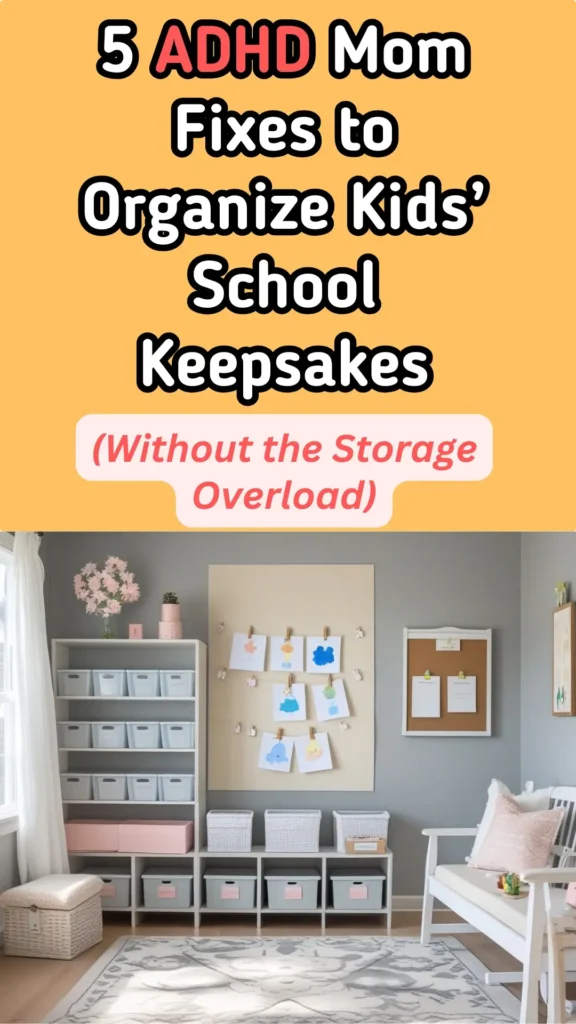If you’re an ADHD mom staring at a mountain of your kid’s artwork, school awards, and every single worksheet they’ve ever touched… hi. Same.
It took me years to figure out how to organize my kids’ school keepsakes without drowning in bins and guilt.
Here’s the thing: it’s not just about the paper clutter. It’s about the mental clutter that comes with it.
That inner voice whispering, “You should be saving this. You’ll regret tossing that. You’re falling behind again.”
Don’t forget to save this pin for later! Trust me, you’ll want to come back to these tips when you’re knee-deep in another pile of glittery macaroni art.

This post is for you if:
You’ve got ADHD and the thought of color-coded scrapbooks makes your skin crawl.
Or maybe you don’t have ADHD, but your brain still short-circuits when faced with a messy pile of glittery macaroni art.
Or your kid has ADHD and you just need systems that work for both of you without causing more chaos.
Either way, these five fixes saved me. I hope they save you too.
✅ 1. Choose One Bin Per Kid (and Let It Be the Boss)
Forget fancy scrapbooks or endless file folders.
Pick one tote per child. That’s it. That’s the whole system.
I use a clear storage bin about the size of a banker’s box. Inside, I added hanging folders labeled by school stages:
- Pre-K & Kindergarten
- Elementary
- Middle
- High School
- “Other” (for dance recitals, sports, Scouts, etc.)
Here’s the key: The bin is the boundary.
If something doesn’t fit, something else goes. It’s a built-in clutter filter (no overthinking required).
Letting the bin make the decisions quietly saved me from endless indecision loops.
And honestly? It made it so much easier to actually enjoy the stuff we do keep.
✅ 2. Use a Daily “Drop Zone” (and Forget Sorting For Now)
I used to try to process everything the day it came home.
Spoiler: I failed. Repeatedly.
Now, we have a paper bin near the entryway. It’s just a basic 9″x12″ open bin (nothing fancy).
Every day after school, my kid drops papers in the bin. No deciding. No sorting. Just drop and go.
ADHD brains (and kids) need that simplicity.
Every few months, usually when the bin starts looking like a paper volcano, we do a quick purge together.
We toss the math worksheets. Keep the special stuff. Move anything worth saving to the big keepsake tote.
This little system keeps the paper from exploding across the house.
Without asking me to be a super-organizer every afternoon. Which is, you know, not a thing I’ve ever been.
✅ 3. Make It a Summer Project (Together)
Once a year, usually during that summer slump when everyone’s bored and whining, we open the big bins.
We sit together, go through the pile from the year, and decide what makes the cut.
It’s weirdly fun. Like a time capsule.
We laugh at the doodles. We keep the ones that make us smile. And we always find something that surprises us (in a good way).
Here’s what I love about this:
It teaches your kid to value their own memories.
It builds emotional connection without turning into a “project.”
And it quietly trains them to let go of what’s not meaningful (huge for ADHD kids).
If your child also has ADHD, this can be an incredible tool for helping them practice decision-making and build routines.
If they don’t? It still teaches reflection and ownership.
Either way, it’s way more fun than sorting papers alone at midnight, crying into a pile of glitter glue.
✅ 4. Create a Rotating Display, Not a Permanent Shrine
Want to keep the artwork without drowning in it?
Here’s a trick: hang one or two clipboards or art frames somewhere visible (maybe the fridge, maybe the hallway).
Let your kid pick their favorites to display. When they bring something new they love? Swap it out.
This system keeps the emotional spark of their creations alive. Without storing 9,000 paintings of rainbows.
And bonus: it makes them feel seen.
When it’s time to rotate, we ask:
Keep for the bin?
Or toss and move on?
The act of choosing (without pressure) builds confidence and autonomy.
It really helps ADHD kids understand that their work is valued, even if it doesn’t all need to be permanent.
✅ 5. Embrace the 10-Minute Declutter (and Let That Be Enough)
Here’s a mindset shift that changed everything: Decluttering doesn’t have to take all day.
I used to avoid keepsake piles because I thought, “If I can’t do it right, I won’t do it at all.”
Sound familiar?
Now, I set a timer for 10 minutes. That’s it.
We sort what we can. Toss a few things. Maybe file one folder. Then walk away.
It’s not perfect. It’s not Instagram-worthy.
But it’s done. And for my ADHD brain, that tiny sense of closure is gold.
Final Thoughts (And a Gentle Nudge)
If you’ve been feeling guilty or behind, I promise, you’re not alone.
You don’t have to save everything.
You don’t have to organize like Pinterest.
You don’t need a color-coded memory archive.
You just need a system that works for your real life. Something ADHD-friendly, emotionally meaningful, and simple enough to stick with.
Whether your kid has ADHD or not, these small shifts can give you back your sanity.
And give your child a collection of memories they’ll actually appreciate one day.
Let go of perfect.
Hold onto what matters.
And toss the rest with zero shame.
You’ve got this. 💛
Pin this post to save these tips for later! Your future overwhelmed self will thank you.